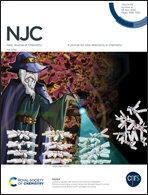Effect of microplate size on the semiconductor–metal transition in VO2 thin films†
Abstract
VO2 thin films composed of irregularly shaped microplates have been synthesized using V2O5 as a precursor via the vapor transport technique. SEM images showed that the microplate sizes in VO2 films tended to increase (from 16 to 51 μm) with increasing quantity of V2O5 precursor due to the large nuclei of VO2 crystals formed at the initial growth stage under a relatively large amount of precursor. Raman, XRD and XPS analysis collectively demonstrated that these film structures have high crystal quality of monoclinic VO2 phase. Furthermore, the thermally driven phase transition was investigated by measuring the electrical resistance during the heating and cooling process. All the films exhibited a typical semiconductor–metal transition at 340 K, and the highest resistivity change reached 4.2 decades. More significantly, the phase transition behaviors show a noticeable variation in the amplitude of the resistivity change, which becomes more prominent as the VO2 film microplate size grows. The relevant mechanism is considered to be predominantly associated with the electron scattering attenuation effect, related to a decrease in the grain boundary density as the microplate size of the VO2 films grows. Additionally, a device based on a high-quality VO2 thin film exhibits efficient IR response, with high responsivity (∼12.5 mA W−1) and fast response speed (∼40 ms) under ambient conditions, which should be promising for sensitive IR detection.



 Please wait while we load your content...
Please wait while we load your content...